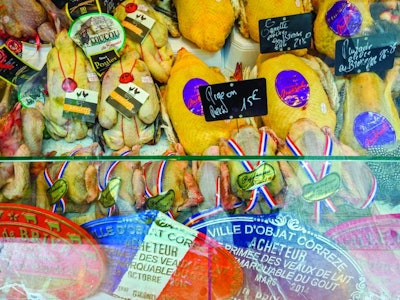
The French broiler industry is suffering an unprecedented crisis, says the country’s broiler producers’ association ANVOL. Farms across species have been hit by the worst ever outbreak of highly pathogenic avian influenza (HPAI) and rising input costs, particularly for feed and fuel, exacerbated by the war in Ukraine.
Worst ever outbreak
France is not the only European country struggling with HPAI, and this latest outbreak is not France’s first. But the current outbreak is said to be the worst that the country has ever experienced, with significantly more cases occurring than in its neighbors.
This latest outbreak first emerged in late November last year on a layer farm in the north of the country, before spreading to the southwest. Once infections there began to stabilize, the disease emerged in the Pays de Loire, the country’s second most important poultry producing region, growing in intensity and virulence, notes ANVOL.
As of April 26 this year, 1,348 HPAI outbreaks on commercial farms had been recorded, along with 46 in wild birds and 30 in backyard flocks, Ministry of Agriculture data reveals, with Pays de Loire, in the west of the country, recording more than double the number of outbreaks recorded in the southwest. By comparison, the next hardest hit country in Europe has been Germany with 1,264 outbreaks, however, 1,183 of which were in wild birds.
Data published for 2020 by ITAVI reveals that France’s poultry meat flock comprised 936.4 million birds, with 829.4 million being chicken. The country is home to approximately 2,700 egg farms. Both sectors are highly concentrated in the west of the country.
Since December, the French poultry flock has declined by at least 14 million due to infection or preventative slaughter. New outbreaks are said to be occurring every day.
All sectors of the poultry industry are being affected. Within the duck sector, grandparent and breeding flocks have been affected and the industry is said to be on its knees and not expected to recover for at least two years. The genetics for both ducks and guinea fowl are said to be at risk.
Lower availability
In late March, ANVOL warned that the market would face temporary shortages for some poultry products, and this was echoed by LDC, Europe’s largest producer slaughtering approximately 580 million broilers per annum. With numerous operations in the affected region, LDC has warned that its output will be significantly lower over the months ahead.
The company notes that it has started its financial year in a situation that it has never seen before, created by HPAI and rising costs. It warns that there will be 30% less poultry meat available on the French market over the coming months, adding that it should be able to limit the impact on its own business, with volumes expected to be 20% lower between March and August.
However, it is not only HPAI that is currently harming the French industry. Like others around the world, French producers are suffering the effects of rising feed and fuel prices and the situation is expected to worsen.
In late March, ITAVI forecasts suggested that, over the subsequent four months, feed prices would rise by the equivalent of the entire increase recorded of the previous 19 months. This would mean that by July this year, feed prices in France would have doubled from July 2020.
France is Europe’s fourth largest poultry meat producer, behind Poland, the U.K. and Germany. Some external commentators have suggested the sector’s current difficulties, combined with structural issues, could see the local industry lose yet more ground to foreign competition.

French consuming more chicken
Poultry meat consumption in France, both in- and out-of-home, increased by 1.9% last year by volume, according to the latest data from industry association the federation of poultry industries (FIA).
This increase was mainly due to the re-opening of the restaurant and catering sectors and total consumption across species on the home market stood at 1.92 million metric tons.
The increase was down to greater demand for chicken meat, which accounts for over 75% of total poultry meat sales in France and rose by 5.4%. In contrast, sales of turkey meat contracted by 7.8%, while those of guinea fowl were 7.7% lower.
FIA notes that retail sales of poultry meat, in comparison with 2020, were almost 6.55% lower, but notes that 2020 was an unusual year, with demand at retail rising sharply due to lockdowns and consequent at-home consumption.
When 2021’s retail sales are compared with those of 2019, retail purchases were 2.6% higher. Chicken sales, in particular, were 10.7% higher.
The return to normality, the association notes, was illustrated by the increase in prepared chicken products, up by 7.8% in comparison with 2019, reflecting consumers changing eating habits and a desire to spend less time in the kitchen.
France records mounting avian flu losses
www.WATTAgNet.com/articles/44864

















